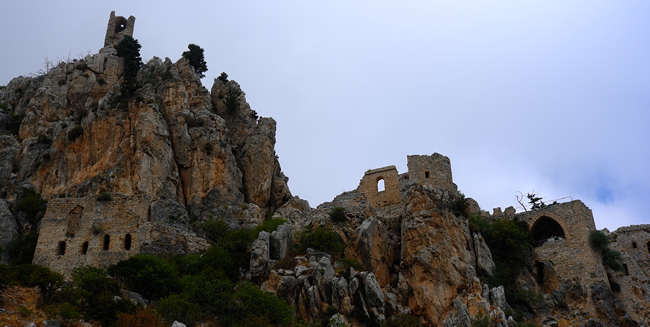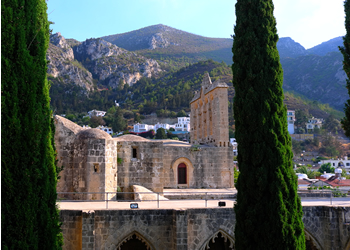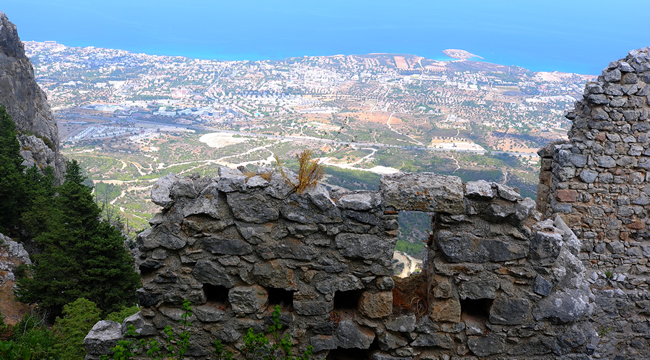

Author Guided Tour: Dominic Selwood Explores Northern Cyprus
Crusaders in the Clouds
After a roadside snack of warm pitta bread, fresh tahini, and fire-cooked shaftalia sausage, I headed for the armed border guards.
A number of people had told me that now was not a good time to do this. But I wanted to write a scene set on the other side of the checkpoint, and I like to visit the places in my books.
The militarized border is an ugly weal running through the ancient city of Nicosia. It carves off the northern third of the island, under Turkish armed occupation since the invasion in 1974.
If that did not create a strained enough situation, recent events have made them worse. For a start, there is no effective border between Turkey and the so-called Islamic State. Additionally, just the previous month, Turkey’s armed forces turned on their own government with tanks and helicopters. Their attempted coup d’état was over in a night, but it left 300 people dead, over 2,000 injured, and triggered a savage crackdown of revenge arrests.
The border crossing itself is almost mundane—a series of armed checkpoints choking off a narrow pedestrian street. But what it represents is genuinely dramatic—the last divided capital in the world.
Cyprus has a special place in my affections. I’m English, and grew up in the timeless Wiltshire countryside around Salisbury and Stonehenge. But when I was small, we moved to the south of Cyprus for several years, and my first memories are of the island’s rugged landscape and inexhaustible history.
Once past the unsmiling Cypriot border guards, I headed on foot into the eerie and dilapidated corridor of the U.N.-controlled no man’s land. It is a sad stretch of derelict houses leading up to the Turkish checkpoints.
Military occupation is nothing new to Cyprus. Almost every major civilization has colonized or conquered it. Just a few hours wandering around any of the sun-scorched landscape brings you into immediate contact with vestiges of its Greek, Phoenician, Roman, Byzantine, Crusader, Arabic, Ottoman, and British past.
In my Ava Curzon books, the heroine is an archaeologist specializing in the ancient Middle East, which Cyprus bordered. Ava followed her father into MI6, Britain’s foreign intelligence agency, where she excelled, but left in the wake of his murder and her disillusionment with the Iraq war. The stories are (hopefully) fast and adventurous, propelling her and the other characters all over the globe as they solve knotty ancient riddles and clues.
Sitting in England a few months earlier, I had decided that a key scene in the new Ava Curzon book, THE APOCALYPSE FIRE, was going to take place at Saint Hilarion castle in northern Cyprus. So it felt good to be making my way there.
Once across the border, the drive out of Nicosia runs north over a wide flat agricultural plain. Within half an hour, the Kyrenia mountains loom ahead, and in no time the road is bending upwards. On cresting the range, there is a monumental statue of Kemal Atatürk, visible for miles in all directions, and then the road drops sharply down to the coast, and the ancient harbor of Kyrenia. I was looking forward to some locally caught fish there that night, but for the moment my journey lay another way—off the main road, and on towards a vertiginous peak I could see out of the window.
Turning west, the route quickly leads into a hi-security military area with draconian restrictions on stopping and photography. After some more snaking, climbing ever higher, there is suddenly a small dusty parking area, where a simple sign announces, ‘ST HİLARİON KALESİ’.
The medieval Crusader castle ahead that rises impossibly from the rocks is one of three castles in the Kyrenia mountains—each one visible from the last. While the others have romantically evocative names: Buffavento (“Wind Defier”) and Kantara (“Bridge”), Saint Hilarion is named after an intrepid—and very reclusive—hermit, who first built a rickety dwelling there among the eyries.
I have to confess that I had an ulterior motive for coming to this castle.
I researched my history doctorate on the medieval Knights Templar and other Crusaders. I remember a dark and rainy winter evening in Oxford, sitting in the airy baroque calm of the magnificent Codrington library. Quite by chance, I came across some notes by Lawrence of Arabia, who—when he had been an undergraduate—had walked a thousand miles across Syria and Palestine to prepare his dissertation on Crusader castles. Ever since, it has been an ambition of mine to see as many of them as I can, and Saint Hilarion has been on the list for a long time. Given the rate at which other Crusader castles in the wider Middle East region are now being destroyed, I am now feeling some urgency about this. (And, in fact, the destruction of ancient artefacts and buildings on the battlefields of the modern Middle East is an ongoing theme in the Ava Curzon books.)
Standing in the deserted car park, looking up, there is a mass of craggy rock rising to a peak several hundred metres further up the mountain, with Saint Hilarion’s medieval walls, battlements, towers, and chambers clinging solidly to it as they wind their way skywards.
From the minute you enter through the vast curtain wall, you are subsumed in a vast and intricate medieval world of defensive towers and walkways. Unlike in England, where unsafe buildings are strictly off limits to the litigious public, Saint Hilarion offers several hours of broken and rubble-strewn steps, no warning signs (except against picking plants), a scattering of ineffectual handrails, and lots of sheer drops into the surrounding gorges.
After a short climb with only geckos for company, I arrived in the middle ward, where there is a cluster of fortified buildings around a massive chapel. Just beyond it is the open-walled belvedere, where thirteenth-century ladies sat in their silks and gazed out over the peaks and valleys. The view is dizzying. God help them if they had vertigo. As I looked out, the military atmosphere of the ruins was thoughtfully enhanced by the sound of the Turkish army detonating ordnance further down the mountain.
The middle ward ends abruptly in a series of stone steps. They are set into the rock face, and wind even higher, twisting left and right as they follow the contour of the mountain. For visitor reassurance there is a flimsy metal handrail to protect the climber from a spectacular descent into a very deep ravine. (The official guide leaflet, naturally, makes much of the various unhappy souls who were hurled off the castle’s walls for one reason or another.)
The third ward sits on top of the mountain, and the views out over the island are simply heart-stopping. This penthouse level was reserved for the royal family, and it is here that I wanted to set my scene.
Breathing in the hot air, I was not disappointed. (Did I mention that it was 101 degrees in the shade?) The Gothic mountaintop is an ideal place for a clandestine meeting between a jihadi flogging Islamic State looted antiquities to a bent London gallery dealer. It was a place of high intrigue centuries ago, and it is the perfect setting for some skulduggery now.
Standing among the clouds and eagles’ nests, gazing out over distant Kyrenia and the azure water of the Mediterranean, it is impossible not to daydream yourself back to medieval times.
In 1191, two wealthy women from Europe—Joanna and Berengaria—were shipwrecked on Cyprus. The island’s ruler was a thug named Isaac, who swiftly imprisoned them. Unfortunately for him, Joanna was the sister of King Richard the Lionheart of England, and Berengaria was his fiancée.
Richard—who was en route to join in the Crusades—unleashed his troops on Cyprus. Isaac made the wise decision to run, but he did not do it quickly enough, and was soon picked up. Richard consoled Isaac by promising not to bind him in iron chains—so he trussed him up in silver ones instead, before packing him off to fester in the dungeon of a Hospitaller castle in Lebanon.
Although now master of Cyprus, Richard’s mind was elsewhere. He was on a mission to reconquer Jerusalem after its catastrophic fall to Saladin. Seeing a chance to make some money, Richard offloaded Cyprus onto the Knights Templar, who in turn sold it to the Lusignans—a family of French wannabees who had managed to breed themselves into the royal family of Jerusalem (as all fans of Ridley Scott’s Kingdom of Heaven will know.) The Lusignans quickly recognized the importance of the Kyrenia mountains, and built the castle of St Hilarion we see today.
In no time, Cyprus became a vital staging post for the Crusaders, who intuitively understood what warriors down the millennia have always known. The island is a unique crossroads between Europe and Asia, with unrivalled strategic importance in the eastern Mediterranean.
And it still is.
On my way to the border that morning, while still on Greek Cypriot soil, I had passed within a few miles of RAF Akrotiri, from where British Tornados and Typhoons roar into their aerial missions against the Islamic State.
That evening, as I had promised myself, I ate fresh fish on the harbor front in Kyrenia, looking out over the still dark waters, across which—according to legend—Greek survivors of the Trojan war had come to found the town over 3,000 years ago.
I had started my journey that morning in the Greek town of Paphos, wandering around the broken husks of the great Crusader castle built there in 1200, before it came crashing down in the earthquake of 1224. When I had last visited Paphos as a child, it was a sleepy harbor with a couple of ramshackle tavernas and a few pelicans strutting proprietorially among the tables. Since then, like much of coastal Greek Cyprus, it has discovered that people from colder countries are fond of lying on sunny beaches. As I had expected, I could barely see the rickety old harbor under the miles of all-year-round holiday hotels.
However, up in the clouds of Saint Hilarion, and in places like the nearby village of Bellapais—with its spectacular rosemary-scented Crusader abbey—there is still something of the rural, sleepy, history-encrusted island I remember.
As I finished my fish, I sat back to enjoy the smell of hot stone, salty seawater, Mediterranean herbs, and grilling food. Looking about, I gazed up into the mountains, and soon spotted the faint lights of Saint Hilarion, still guarding the shoreline.
I ordered another beer.
It had been a day well spent. I had discovered something again of the island I remembered from my childhood. But more importantly, I had definitively found the unparalleled setting I wanted for my chapter.
Thank you, Joanna and Berengaria.
*****
 Dominic Selwood is the author of the international #1 bestseller THE SWORD OF MOSES, voted one of the top five religious thrillers of all time by BestThrillers.com. He is passionate about everything historical. He writes on history for the Daily Telegraph, and contributes to the Spectator and other national and international magazines. He regularly appears on television and radio talking about history. He studied and researched at university in Oxford, Paris (the Sorbonne), London, Poitiers, and Wales, and has taught and lectured on warfare, religion, the crusades, heresy, and all the fun stuff. He is an elected Fellow of the Royal Historical Society, a former criminal barrister, has lived in Europe and the Middle East, and now lives in London with his wife and two children. His first Ava Curzon book, The Sword of Moses, is an Amazon international number one best seller. His history books include Knights of the Cloister, which is a study of the medieval Knights Templar and Knights of Saint John, and Spies, Sadists and Sorcerers, an international #1 bestseller debunking historical myths. He is also the author of two ghost stories, ‘The Voivod’ and ‘Suffer the Children’
Dominic Selwood is the author of the international #1 bestseller THE SWORD OF MOSES, voted one of the top five religious thrillers of all time by BestThrillers.com. He is passionate about everything historical. He writes on history for the Daily Telegraph, and contributes to the Spectator and other national and international magazines. He regularly appears on television and radio talking about history. He studied and researched at university in Oxford, Paris (the Sorbonne), London, Poitiers, and Wales, and has taught and lectured on warfare, religion, the crusades, heresy, and all the fun stuff. He is an elected Fellow of the Royal Historical Society, a former criminal barrister, has lived in Europe and the Middle East, and now lives in London with his wife and two children. His first Ava Curzon book, The Sword of Moses, is an Amazon international number one best seller. His history books include Knights of the Cloister, which is a study of the medieval Knights Templar and Knights of Saint John, and Spies, Sadists and Sorcerers, an international #1 bestseller debunking historical myths. He is also the author of two ghost stories, ‘The Voivod’ and ‘Suffer the Children’
Follow him on his website and Twitter (@dominicselwood).
- Africa Scene: Iris Mwanza by Michael Sears - December 16, 2024
- Late Checkout by Alan Orloff (VIDEO) - December 11, 2024
- Jack Stewart with Millie Naylor Hast (VIDEO) - December 11, 2024





